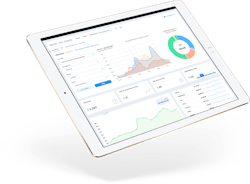Seeking Digital Manufacturer Status? Don't Discount Power of AI
In the world of digital manufacturing, data has in many ways become a commodity. Most equipment today can generate mountains of data and inexpensive sensors enable manufacturers to quickly pull comparable data from legacy equipment. The real power comes from how organizations utilize these data sets and ultimately couple the insights with other technologies to gain a competitive advantage.
AI-driven consumer products company Mohawk Group is a prime example. The company uses an array of data-fueled technologies such as sentiment analysis to identify and fix the pain points its customers have with competing products, partnering with manufacturers to implement an agile and iterative methodology that allows them to launch new products within 6-8 months.
When Co-Founder and CEO Yaniv Sarig started Mohawk Group six years ago, the team quickly realized that consumers were making more and more purchases online, and that they were leveraging data more than ever in their decision-making. “We realized that shoppers were shifting towards comparing pricing, features and product reviews rather than relying on traditional brand names to assess the value of their purchase,” says Sarig. “We set out to create a truly modern CPG company – one that uses real-time data from e-commerce platforms to properly assess what consumers really want and to bring to them in the most efficient manner products that deliver value at competitive prices.”
The Mohawk team spent the next five years developing AIMEE (Artificial Intelligence Mohawk E-commerce Engine) – a software platform designed to manage end-to-end the e-commerce supply chain for its owned and operated brands. As part of the software, Mohawk developed a market research engine to identify new product opportunities.
“We process approximately a terabyte of market data every day from various online sources to help determine product opportunities. We track searches, reviews, price points and various other parameters to better understand the changing needs and desires of consumers,” he says. “We use Natural Language Processing to rapidly extract consumer sentiment for specific products and product categories. We also incorporate various predictive algorithms to estimate the volume of an incumbent’s product sales, among other things, with a view to determining the potential market size of an opportunity.”
Most of the company’s revenue today comes from the sale of products that it brought to market under its portfolio of brands. To date, Mohawk has launched over 250 products, scaling net revenue to $114.5M in 2019.
With the vision for AIMEE to drive the entire supply chain for its brands, Mohawk continues to invest in AI implementations to improve forecasting and to automate marketing. Sarig foresees this effort to continue in perpetuity as more algorithms become available and we experiment with additional real-world data features to improve its models.
“We have very ambitious goals when it comes to the automation of the day to day management of e-commerce and this includes from the moment products are shipped from the factory until they arrive at the door of the consumer,” he says. “Today, AIMEE is able to manage marketing variables such as pricing and media buying under the constant supervision of our experts on the marketplace team. For us, AI is about empowering our employees. We want to give our expert marketing team the ability to manage thousands of products with the same effort they would use to manage a hundred of them. We believe that as the direct-to- consumer model compresses the supply chain and drives competition, scalability at the organization level can be achieved through technology and automation. Essentially, our goal is to build the most efficient consumer product company in the world, managing massive amounts of revenues while keeping our fixed costs as flat as we can. All while delivering high value products at a competitive price.”Sarig tells IndustryWeek, AI is still challenging to implement when trying to solve real world problems, especially in a dynamic and ever evolving world of consumer good and online retail. “Probably one of the most difficult challenges we are facing and will continue to face, is data consistency and noise,” he says. “As we attempt to make automated decisions and predictions using various data points in real time, a single noisy feature in the data can leak into our models and drive the wrong conclusion. We follow industry best practices when applying data sanitization techniques but when you are building production level software and look to add new features every week things can go wrong.”
Mohawk uses caution when deploying new algorithms in a monitored way, which sometimes means taking three steps back in order to take five steps forward, explains Sarig. “Since our systems help us manage critical financial and operational decisions daily, we need to find the right balance. Another less talked about challenge with AI and automation is cultural. The name AI conjures with many an expectation of intelligence that is comparable or superior to humans,” he says. “Across the tech industry we are not there yet and it’s debatable if we ever will. For us, we think of automation in general and AI algorithms as mechanisms to augment human efficiency in making decisions at scale as opposed to applying autonomous complex critical thinking.”
For example, optimizing advertising campaigns is data intensive, laborious and often counter intuitive. “Can a human beat a machine at doing so when managing one product daily? Probably, although we are seeing many aspects of this task where they would not,” he says. “When you need to manage a hundred or a thousand products humans just can’t keep up. The amount of time necessary to assess all market conditions and make decisions every day is enormous. If an algorithm can augment decision-making and productivity for our people, it’s a huge win for us.”
As more manufacturers progress along the digital revolution, AI will continue to generate interest as a driving force for the future of business. Sarig recommends taking a step beyond interest – and the sooner the better. “The first is cultural, as an organization it is important to start early with getting teams to think of AI’s role in the business, now and in the future. You want everyone in the organization to be exposed to the capabilities, benefits and limitations of AI so that they can think of various applications within their role,” he says.
“The second reason is data architecture, an organization looking to truly leverage AI at scale will need to fundamentally rethink how data is collected and organized. AI requires a lot of data, both internal and external. The earlier a company can start collecting and storing the relevant datasets it will need to use to train models, the better armed it will be to leverage such historical data for training purposes,” says Sarig. “Lastly, we believe that the earlier engineering talent thinks of AI in the context of the problems they are solving, the better systems will be engineered long-term to continue to leverage the rapid improvements in this exciting space.”
About the Author
Peter Fretty
Technology Editor
As a highly experienced journalist, Peter Fretty regularly covers advances in manufacturing, information technology, and software. He has written thousands of feature articles, cover stories, and white papers for an assortment of trade journals, business publications, and consumer magazines.

